Cleaning a Microscope Focus Mechanism
Model: aus Jena Laboval 2
Rik
Littlefield
This brief note documents how I refurbished the focus mechanism of an
aus Jena Laboval 2 microscope.
These are just my working notes. I guarantee that the described
procedure is not the best way to do the problem, because it failed
quite badly at one point. On the other hand, maybe you can get
some insight that will help with some similar problem.
The problem was simple: my 25+ year old aus Jena Laboval 2 microscope
had developed a severe case of "sticky focus" due to hardened
grease. Obviously what it needed was to be disassembled, cleaned,
lubricated, and reassembled, and then all would be fine again.
Unfortunately, this particular model of microscope is fairly
rare and I could not find technical documentation for it.
So I tackled the problem cautiously by trial and error.
The first time, It took about 6 hours including think-time, to figure
out how to get
completely into the beast without breaking anything. (The task
was complicated by the fact that some things that were supposed to come
apart, were stuck hard together.)
But by this point, I've had it apart and together three times, and the
process is starting to seem pretty simple.
Here's how it goes.
- Remove binocular head.
- Remove all objectives.
- Remove condenser.
- Lay instrument on left side.
- Remove base plate and set aside.
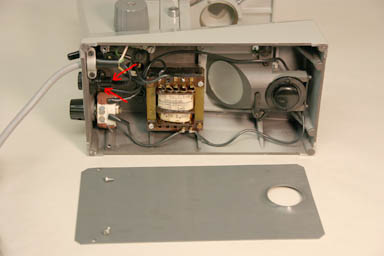
- Unsolder fuse holder.
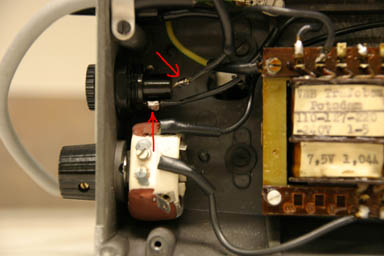
- Unscrew and remove fuseholder, exposing 3 mounting screws that
hold the microscope's body to its base.
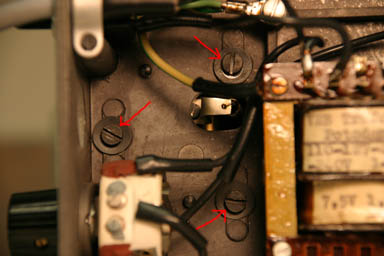
- Unscrew & remove those 3 mounting screws.
- Remove microscope body from base.
- Remove stage (4 screws).
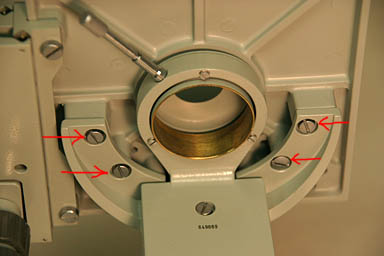
- Remove 2 screws holding condenser mount.
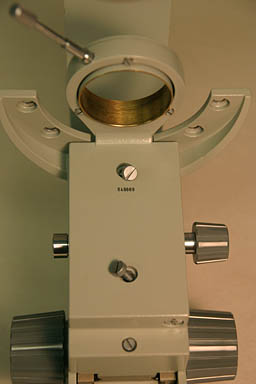
- Pull condenser mount straight
off (do not allow to pivot).
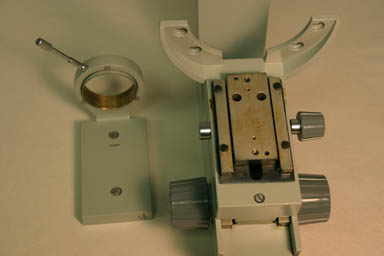
- Align condenser rack to expose two screwheads underneath it, then
remove 3
screws & remove condenser rack assembly.
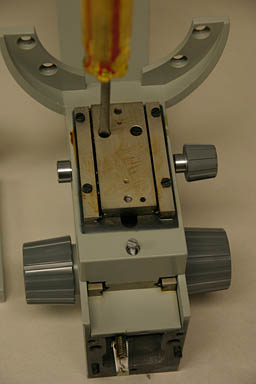
- Remove 2 screws and the cap above the focus slide assembly.
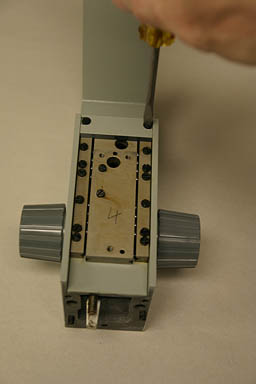
- Loosen 4 setscrews on sides of frame (see next photo).
- Remove 4 screws holding focus slide assembly to frame.
(Caution - be
sure to select the 4 long ones! They're in positions 1 and 5,
counting from the bottom. If you loosen more than one of the
others, you'll start disassembling the slide. The picture shows
the proper 4, unscrewed most of the way.)
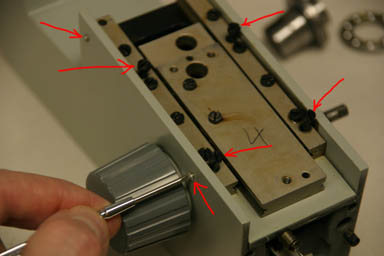
- Loosen 2 screws holding down the bracket on which pivots the
focus spur gear.
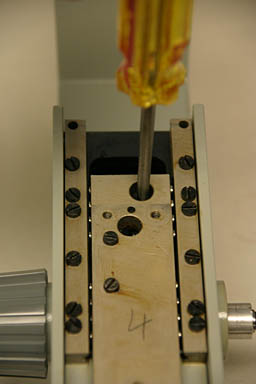
- Rotate the focus slide out and down to expose the spring bracket
screw.
- Remove the spring bracket screw, remove & set aside the focus
slide assembly.
- Remove 2 screws holding the focus spur gear bracket in place,
remove
assembly & set aside. (This picture shows one of the two
screws, but the shot was taken out of order, with the focus slide still
in place.)
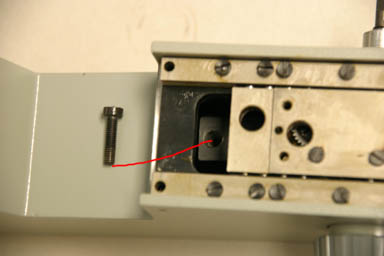
- Remove screws holding left and right focus knobs in place, remove
knobs and whatever else wants to come off.
- Loosen 2 setscrews from bottom of frame, slide worm assembly out
of frame. (This step can be omitted if you don't need to remove the
brass enclosure of the worm assembly from the frame.)
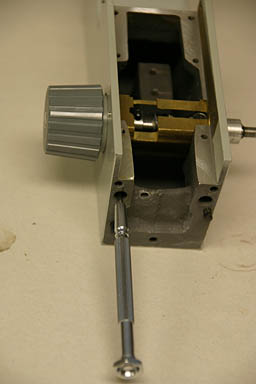
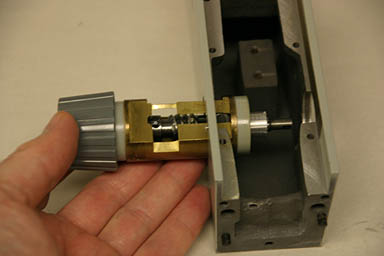
- Remove the left stopscrew from the worm assembly. This
allows the worm to be withdrawn so that the second screw can be
removed. Removing the second screw allows the entire worm to be
pulled out of the brass enclosure.
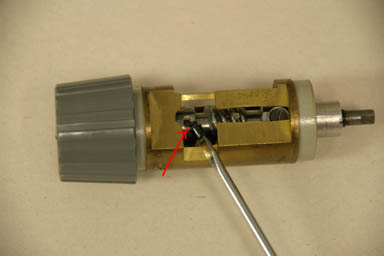
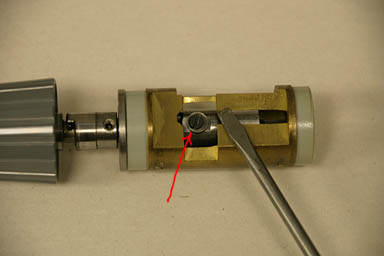
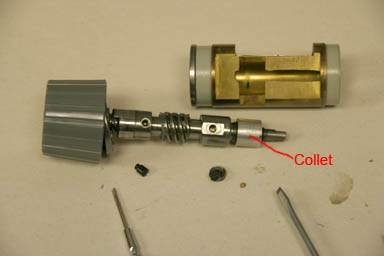
- Clean thoroughly all parts.
- Remove the threaded collet from the worm gear. Oil very lightly only the
threads of the small shaft that runs through the
worm. (Nye Hobby Gear Lube PP269 Light Viscosity Oil.)
Reinstall and tighten the threaded collet only enough to remove any
play
in the mechanism -- no added drag should be felt.
- Lubricate worm with light grease (Nye Hobby Grease 362HB
Multi-Purpose Grease).
- Lubricate rack if you feel like it. (Lore has it that racks
are all made to run dry. But this one was greased by the
manufacturer.)
- Lubricate ball bearings with light grease -- again no added drag
should be felt.
- Lubricate side bearing surfaces of the worm with light grease -- not oil! (See CAUTION
below.)
- Lubricate plastic washer at right end of worm with silicone
lubricant.
- -------
- To reassemble, reverse steps. When reassembling the focus
spur gear, be sure to properly position its stop and the focus rack so
that
the thing will move all the way up and down.
Miscellaneous notes...
CAUTION: the side bearing surfaces of the worm's brass enclosure are
coated with some plastic material that can absorb oil, causing it to
swell and jam up solid. This happened to me once -- the scope
worked
fine right after reassembly, was stiff by the next day, and on the
second day was stuck so tight that it had to be disassembled by impact
using a wooden dowel. After soaking overnight in solvent,
followed by
complete drying, the parts could be reassembled but were still too
stiff to operate well. I ended up chucking the brass enclosure in
a
metal lathe and carefully shaving about 0.0005" off the plastic bearing
surface, before everything worked well again. Next time, I lubed
those
surfaces with Nye Hobby Grease and made sure there was no liquid oil
around.
Fine focus is accomplished by turning the small threaded shaft that
goes through the middle of the worm, but not the worm itself, so that
the worm is moved slightly left and right. Fine focus drag is
determined only by friction of the ball bearings and of the thread that
moves the worm. Both these should be very slight.
Coarse focus is accomplished by turning the whole worm within its
enclosure, dragging along with it the slotted inner bearing race on the
right side (with frame down, base toward you). Coarse focus drag
is determined (potentially) by friction between the worm and the left
hand bushing, and (definitely) by friction on the right side between
the slotted inner bearing race and the microscope frame, mostly via a
plastic washer. Coarse focus drag is much more than fine focus
drag. Lubricate that thing with the slipperiest goo you can
find. (Teflon, silicone?)
Note that the whole focusing mechanism is preloaded by the weight of
the stage and added force from the spring. It is OK, probably
preferable, if there's a bit of play between the focus rack and its
mating spur.
There's a tendency for the end of the worm stop screw to rub against
the spring that pulls the focus slide down. This makes an
annoying
sound. During reassembly, check for this, and adjust the spring
bracket and spring position so it doesn't happen.
The focus slide and the condenser adjustment slide seemed to still be
working OK, so I didn't bother to clean or re-lube them.
--Rik Littlefield
April 28, 2007































